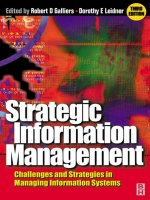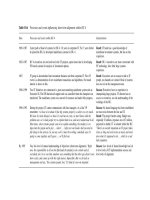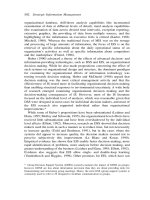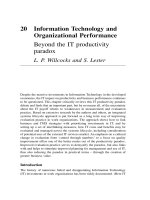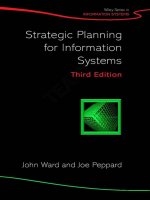Managing information systems 7th edition brow ch05
Bạn đang xem bản rút gọn của tài liệu. Xem và tải ngay bản đầy đủ của tài liệu tại đây (1.68 MB, 48 trang )
MANAGEMENT INFORMATION SYSTEMS
CHAPTER 5
ENTERPRISE SYSTEMS
Copyright © 2011 Pearson Education, Inc. publishing as Prentice Hall
5-1
PART II - APPLICATION AREAS
Intra-organizational systems:
•
Enterprise systems: (Ch. 5)
support all or most of the organization
•
Managerial Support systems (Ch. 6)
support a specific manager or group of managers
Inter-organizational systems:
•
e-Business applications (Ch. 7)
- B2C – link businesses with end consumers
-
B2B – link businesses with other businesses
Intermediaries
Copyright © 2011 Pearson Education, Inc. publishing as Prentice Hall
5-2
CHAPTERS 5 AND 6
Intra-Organizational systems
Copyright © 2011 Pearson Education, Inc. publishing as Prentice Hall
5-3
CRITICAL CONCEPTS
Batch processing
•
•
A group (or batch) of transactions are accumulated, then processed all at one time
Key Disadvantage: Time delay before the master file updated
Copyright © 2011 Pearson Education, Inc. publishing as Prentice Hall
5-4
CRITICAL CONCEPTS
Online processing
•
•
•
Each transaction is entered directly into computer when it occurs
Interactive System: A fully implemented online system where user interacts directly with the computer
In-Line System: Provides for online data entry, but processing of transactions is deferred for batch processing
Copyright © 2011 Pearson Education, Inc. publishing as Prentice Hall
5-5
CRITICAL CONCEPTS
Batch processing vs. Online processing
Batch Processing
• Significant delay before master
file is updated (usually 1 day)
• Much less expensive to
operate
• Some applications naturally
suited for batch processing
Online Processing
• Master file updated within a
fraction of a second
• Much more expensive to
operate
• Some applications need to be
processed in real time
(e.g., payroll)
Given these tradeoffs, hybrid systems that combine online data entry,
Copyright © 2011 Pearson Education, Inc. publishing as Prentice Hall
with batch processing, are very common
5-6
CRITICAL CONCEPTS
Functional information systems
•
Information systems that support one primary business function or process of an organization
Example Business Functions and Subsystems
Marketing
Accounting
Production Planning
Production Scheduling
Copyright © 2011 Pearson Education, Inc. publishing as Prentice Hall
Personnel
Personnel
Engineering
Sales Forecasting
Etc.
5-7
CRITICAL CONCEPTS
Vertically integrated information systems
•
Serve more than one vertical level in an organization or
industry
Top Management
Long-term trend analysis
Sales System Example
Middle Management
Weekly data analysis to
track slow-moving items
and productive salespeople
Produce invoices
Capture initial sales data
Copyright © 2011 Pearson Education, Inc. publishing as Prentice Hall
5-8
CRITICAL CONCEPTS
Distributed systems
•
Refers to mode of delivery: Processing power is distributed to multiple sites, which are linked via
telecommunications
Client/server systems
•
A type of distributed system where processing power is distributed between a central server
computer and a number of client computers (usually PCs)
Copyright © 2011 Pearson Education, Inc. publishing as Prentice Hall
5-9
CRITICAL CONCEPTS
Client/server systems and Middleware
Middleware
Client
•
•
Handles user
•
Software to support
interface
clients and server
Accesses distributed
interaction
services through a
network
Copyright © 2011 Pearson Education, Inc. publishing as Prentice Hall
• Three categories:
– Server operating systems
– Transport stack software
– Service-specific software
Server
•
•
Runs on bigger machine
Handles data storage
for applications …
–
–
–
Databases
Web pages
Groupware
5-10
CRITICAL CONCEPTS
2- tier vs. 3- tier Client/server systems
3-tier system
2-tier system
- Original model
- Popular beginning
mid-
1990’s
Client
Client
Server
Application Server
Database Server
Copyright © 2011 Pearson Education, Inc. publishing as Prentice Hall
5-11
CRITICAL CONCEPTS
Client/server systems and Fat/Thin Models
•
Fat client/thin server: most processing done on the client
Ex: Web and groupware servers
•
Thin client/fat server: most processing done on the server
Ex: Database servers
Copyright © 2011 Pearson Education, Inc. publishing as Prentice Hall
5-12
CRITICAL CONCEPTS
Virtualization
•
Server Virtualization:
- Physical server split in multiple virtual server
- Each virtual server can run its own full fledged operating system
- Physical server acts as a hypervisor program creating virtual servers
- Each virtual server can be employed as a standalone physical server, reducing the number of physical servers needed
•
Desktop Virtualization:
- Implemented through a client server computing model
- Virtualized desktop environment stored on a server then on local storage of desktop device
- All the programs, application and data are kept on the server and all programs and applications are run on the server
Copyright © 2011 Pearson Education, Inc. publishing as Prentice Hall
5-13
CRITICAL CONCEPTS
Service-oriented architecture (SOA)
•
Application architecture based on a collection of functions, or services, where these services can communicate (or be
connected) with one another
•
Advantages:
- Once a service is created (internally or externally) it can be used over and over again
Web services
•
•
Collection of technologies built around the XML standard of communicating
Other protocols used in web services include:
- Web Services Description Language (WSDL)
- Universal Description, Discovery, and Integration (UDDI)
- SOAP (originally Simple Object Access Protocol)
Copyright © 2011 Pearson Education, Inc. publishing as Prentice Hall
5-14
TRANSACTION PROCESSING SYSTEMS (TPS)
•
Thousands of transactions critical to business operations are processed each day in large organizations for sales,
bills for sales and customer payments, inventory shipped and received, payments to employees, etc.
•
Typical outputs: invoices, checks, orders, reports
Copyright © 2011 Pearson Education, Inc. publishing as Prentice Hall
5-15
TRANSACTION PROCESSING SYSTEMS
Payroll system
•
System to produce payroll checks also
contains numerous subsystems
Copyright © 2011 Pearson Education, Inc. publishing as Prentice Hall
5-16
TRANSACTION PROCESSING SYSTEMS
Order entry system
•
•
•
Sales Order Processing or a Query
Output includes invoices for sales orders
Linked to other subsystems
Copyright © 2011 Pearson Education, Inc. publishing as Prentice Hall
5-17
ENTERPRISE RESOURCE PLANNING (ERP) SYSTEMS
Enterprise Resource Planning (ERP) Systems
•
Set of integrated business applications (modules) that carry out common business functions
•
Transaction data accessible to workers in multiple functional units (sales + accounting +…)
Process-oriented way of doing business
- Not separate systems for separate functions
- Support for “Order fulfillment,” not just Sales
•
•
Usually purchased from a software vendor
ERP = “First wave” of enterprise system packages
“Later waves” of enterprise system packages
-
Customer relationship management (CRM)
Supply chain management (SCM) systems
Copyright © 2011 Pearson Education, Inc. publishing as Prentice Hall
5-18
ENTERPRISE RESOURCE PLANNING (ERP) SYSTEMS
By mid-1990s, SAP and other vendors designed “suites” of integrated modules for “back-office” transaction processing that
eliminated the need for many custom-developed interfaces
3 Modules for Value-Chain Activities
S
U
Materials
Production/
Sales/
Management modules
Operations modules
Distribution modules
C
U
P
S
P
L
Procurement
Production
T
Distribution
O
I
M
E
E
Financials/Accounting modules
R
S
R
Human Resources modules
S
2 Modules for Enterprise Support Activities
Copyright © 2011 Pearson Education, Inc. publishing as Prentice Hall
5-19
ERP SYSTEMS, Continued
•
•
•
Suite from one vendor OR “best of breed” from multiple vendors
Some organizations implement Enterprise Support modules only
( Financials, HR)
Value-Chain module implementations involve large investment of
money and people resources because of
impact on business
•
Have become “essential” systems in many industries
Source: Gartner Dataquest
Copyright © 2011 Pearson Education, Inc. publishing as Prentice Hall
5-20
SAP BUSINESS SUITE
Today’s vendors offer modules
beyond the “back-office” modules
Copyright © 2011 Pearson Education, Inc. publishing as Prentice Hall
5-21
ENTERPRISE RESOURCE PL
ANNING ERP SYSTEMS, continued
ERP Business Benefits
•
Support for Cross-Functional processes
-
Modules were designed to support business processes that involved multiple business functions and multiple
geographic locations
•
Access to Integrated Data via a unified platform
-
Data entered into one module could be accessed in real-time by other modules, by employees in dispersed
business units, if a single centralized database is implemented.
•
Support for Global Transactions
- National currencies are automatically converted to the parent firm’s currency
-
Employees in different countries can see the same screen in their own languages
Copyright © 2011 Pearson Education, Inc. publishing as Prentice Hall
5-22
ENTERPRISE RESOURCEPLANNING SYSTEMS
ERP IT Infrastructure Benefits
•
Centralized Database on Client/Server Architecture
-
•
Software updates with increased functionality from the vendor on a regular basis
-
•
Many early adopters replaced legacy system applications (with separate databases) written for mainframe computers
Companies can avoid high costs of customized system enhancements
Standard IT platform for external transactions and regulatory compliance
- Enables transactions with external suppliers and customers
- Costs avoided for updating legacy systems (e.g., Y2K and Euro compliance)
Copyright © 2011 Pearson Education, Inc. publishing as Prentice Hall
5-23
DATA WAREHOUSING
•
The establishment and maintenance of a large data storage facility containing data on all (or at least many) aspects of
the enterprise
•
Provides users data access and analysis capabilities without endangering operational systems
•
Designed for analysis of data, not efficient operational performance
•
Summary reports may be automatically generated on periodic basis
Copyright © 2011 Pearson Education, Inc. publishing as Prentice Hall
5-24
DATA WAREHOUSING: KEY ELEMENTS
Requires software tools to:
- Construct warehouse
- Operate warehouse
- Access and analyze data from the warehouse
Copyright © 2011 Pearson Education, Inc. publishing as Prentice Hall
5-25

